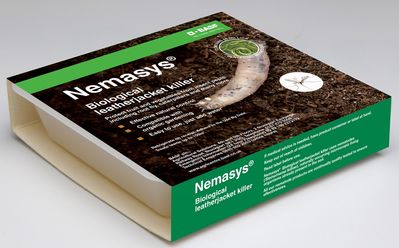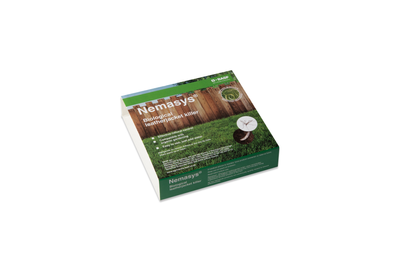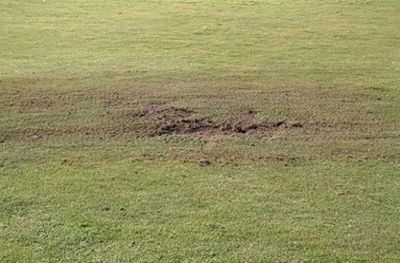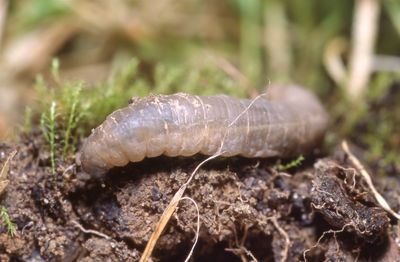Lawns and new build gardens under threat from lurking infestations
Published:
Read Time: 4 mins
As spring unfolds and temperatures rise, homeowners across the country are discovering that their once luscious lawns are being torn to pieces. The culprit of the damage? The lesser-known leatherjacket.
Leatherjackets are small grubs that are the larvae of crane flies, or daddy long legs, and are infesting lawns, wreaking havoc and causing concern among gardeners about the fate of their much-loved turf.
Unfortunately, it would appear that infestations this year are particularly rife. This is because leatherjackets thrive in moist and mild environments, so last year’s damp, warm autumn followed by this year’s even wetter spring has created the perfect conditions for these grubs to thrive! Although harmless to humans and wildlife, these voracious pests can quickly decimate plant roots, seedlings, and grass, and can quickly transform green and gorgeous grass into sparse, brown mud patches. What’s more, the presence of these grubs also encourages birds and mammals to cause further damage as they dig up the garden in search of larvae to feast on, leaving behind rounded, deep holes.
New build homes are under attack!
A surge in videos on social media, and TikTok in particular, has shown new build homes and gardens being hit particularly hard with leatherjacket infestations, and there is a reason for this. Leatherjackets are fussy creatures; they thrive best when devouring young grass that has recently grown or has been freshly laid. This grass is sweeter and has more tender roots compared to old turf which can be tough, bitter, and harder for the leatherjackets to chew through. The other reason is that new builds tend to be located on old meadows and grasslands, which are a natural and preferred home of many insects, including leatherjackets and craneflies.
How to get rid of leatherjackets
Since 2016, all effective pesticides to treat leatherjacket infestations, such as chlorpyrifos, have been banned in the UK. Thankfully, one of the most simple, effective, and biological methods to tackle them and restore lawns to their former glory is to apply nematodes.
Nematodes are naturally occurring, microscopic worms that target and kill common garden pests, like leatherjackets, without causing harm or disruption to other wildlife, pets, or people. Not only are nematodes effective at controlling and destroying pests but applying them to the garden is also very simple. In fact, it’s as easy as watering your garden!
Matthew Martin, from Nemasys, the UK’s largest producer of nematodes, shares his advice on spotting a leatherjacket infestation and how to banish them quickly and effectively for good.
How to tell if you have a leatherjacket infestation
“The easiest way to tell if you have a leatherjacket infestation is to find a grub - they’re not too hard to spot! They have long, elongated tubular bodies and can grow up to 30mms. They have no obvious head or legs and can be brown or black in colour. To encourage them out of the lawn, you can saturate the grass and cover with black sacks or tarpaulin overnight. In the morning, the grubs will have risen to the surface and will be easy to see. They can be discarded by picking them off by hand or left exposed for the birds to consume. With severe infestations, it is possible to lift the first layer of soil with a shovel or trowel and spot the critters wriggling around just below the surface!”
What are nematodes and how do they work?
Nemasys Biological Leatherjacket Killer specifically targets leatherjackets by attacking the larvae, entering through natural openings or pores in the grub’s body, and then releasing bacterium from inside, which infects and kills the pest. Nematodes should be applied directly to the lawn when the soil temperature is
consistently above ten degrees, meaning now is an ideal time to treat your grass.
Applying is simple! The nematodes arrive as dried granules that are then mixed with water in a watering can or suitable sprayer, and simply watered onto the lawn. It’s best to apply them first thing in the morning or during the evening to avoid weakening the nematodes with harsh direct sunlight.
The lawn should be well-watered after the application to wash the nematodes into the soil, and the area should be kept wet for up to two weeks afterwards. For consistent and long-lasting protection, it’s best to repeat the application after two to four weeks to keep your garden grub-free and thriving!
Nemasys Leatherjacket Killer, and other Nemasys beneficial nematode products can be purchased from a selection of online distributors. To find out more, visit the website at https://www.nemasysinfo.co.uk/en/Products/Overview/
Ends
Editors notes
Nematodes are naturally occurring microscopic worms, already present in our soil. Beneficial nematodes attack and kill targeted garden pests. They are compatible with organic farming, easy to use and can even be kept in your fridge!
Research scientists have isolated the nematodes that kill specific garden pests including Slugs, Vine weevils, Leatherjackets, Caterpillars, Codling moth and much more.
BASF’s state of the art production facility in the UK produces billions of nematodes in a form that is easily applied by gardeners. Over 20,000 different species of nematodes have been classified, although some estimates put the total figure closer to one million! BASF has the largest specialist nematode production facility in the world, growing trillions of beneficial nematodes for use in their Nemasys range of pest control products.
BASF experts are available for interviews, features and expert comment on biological pest control management, and product is available for reviews, competitions and product trials.







